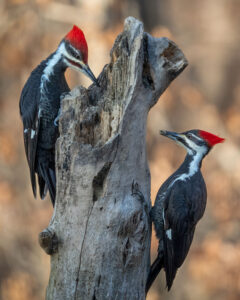Reflections in Nature: Many animals seek shelter, dens in winter
Are you prepared for another Pennsylvania winter? Our furnace and chimney have been cleaned, filters have been replaced, woodshed is full and Mary Alice has our warm coats, scarves, mittens and boots ready for frosty weather. Wildlife shares these same human instincts.
They have been seeking warm dens to spend the winter. During periods of cold and snowy weather, most wildlife will remain inactive, staying in their dens until the weather warms.
Although we have not had mice in the last few years, Mary Alice still has me set mouse traps in our food pantry. Our neighbor — who had many free roaming cats — has recently moved. Although I believe these cats kept the mice population down, they also kept the birds from coming to our feeder.
Animals, such as raccoons, possums, skunks, squirrels and even bears move into barns and outbuildings, while squirrels often seek out attics. A common complaint received by WCO’s is that a skunk (or family of skunks) had found a protected place under a porch.
Webster states that a den is a wild animal’s lair, the hidden home of a wild animal. Our word den comes from the Old English word denn, meaning wild animal’s lair, which ultimately came from an Indo-European word meaning flat surface.
Not all animals invade human structures.
During the winter months, deer will move near stream bottoms, where there is a stand of evergreen trees. Here the snow will not become as deep, and the wind will not blow as strong. These areas are known as deer yards. If the weather is cold and the snow is deep, the grouse might fly into a snowbank, where it will spend the night under the snow. This is referred to as a snow roost.
Many animals, including squirrels, raccoons, mice and even bears, will occasionally move into den trees for the winter. For some animals, a good den tree is necessary to survive the harsh winter months. Hollow trees provide cavities that serve as homes for all sorts of wildlife, from mammals to birds.
After an animal moves into a den tree, the temperature immediately rises. This is due to the animal’s body temperature. A drop in the outside temperature will not affect that of the den for at least two or more hours.
Many birds, such as woodpeckers, black-capped chickadees and even horned owls, will nest in the hollow of trees. It takes a long time for trees to form, sometimes more than 100 years before a tree contains a hollow large enough to become a good den tree. Whether a nest is in an abandoned woodpecker hole or in a natural cavity, a tree den offers better protection from wind, rain, and snow.
Studies have proven another advantage for animals living in dens is that they use less energy in maintaining their body temperatures.
If a squirrel cannot find a tree cavity for a den, it will build a leaf nest which is known as a drey. Leaf nests are common in woods that have a shortage of natural den trees. Oak, beech, elm and red maple trees are favored by squirrels for either a den or leaf nest. Nest building activity mushrooms during June and July when the spring-born squirrels practice building nests, which are often flimsy and seldom last long. Pregnant females about to have their summer litters are busy either building or remodeling nests.
Adults often build several temporary nests during the warmer months, however fall is the most active time for nest construction as both males and females prepare nests for winter. You can tell a summer leaf nest from a winter leaf nest by its location. If the nest is out towards the end of the branch, it is a summer nest. If the nest is built closer to the trunk of the tree, it is a winter nest.
Leaf nests host a variety of activities throughout the year. During December and January, squirrels are in the middle of their mating period. Although squirrels usually live alone, males and females sometimes share a nest with their mate for a short time during the mating season.
Some animals, such as foxes, opossums, porcupines, raccoons, bears and many others, will either dig holes or use abandoned woodchuck holes for dens. A fox den is known as a lair.
I usually think of a bear den as a winter home, however many years ago, Deputy Fox (now deceased) came upon a freshly dug bear den. At the time, a summer heat wave had us all sweltering, and we realized that the bear had dug the deep hole into the hillside to escape the summer heat. During the summer months, a bear will often dig in wet areas and then roll around in the mud to avoid the summer heat.
These holes are referred to as a bear wallow. Bears have more problems with the summer heat than the winter cold.
A female bear will give birth to cubs while in the den. These dens are usually a hole dug in an area that will not flood during the spring runoff. While a male bear will usually den on top of the ground in an area where there is a lot of thick brush. A bear that dens on top of the ground will sometimes be seen during the winter due to being disturbed for some reason. Many times, I have heard about a bear that denned up under someone’s porch.
These reports were usually about females that gave birth to cubs.
Keeping wildlife out of our homes is a yearly task for those people that live in the country. By the end of October, wildlife will begin looking for winter homes, and our homes make ideal dens.
Bill Bower is a retired Pennsylvania Game Commission Wildlife Officer. Read his blog and listen to his podcasts on the outdoors at www.onemaningreen.com.


